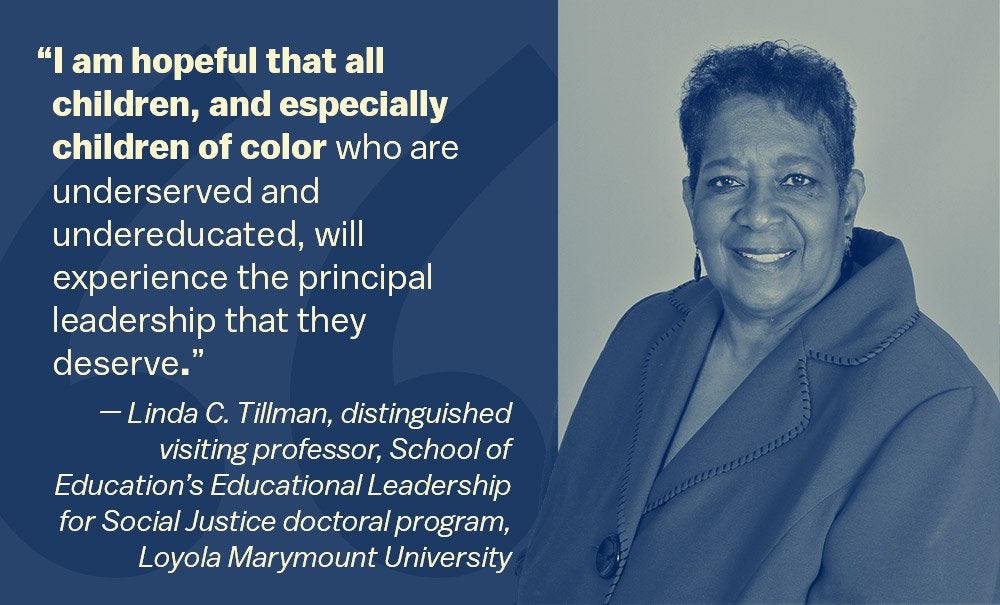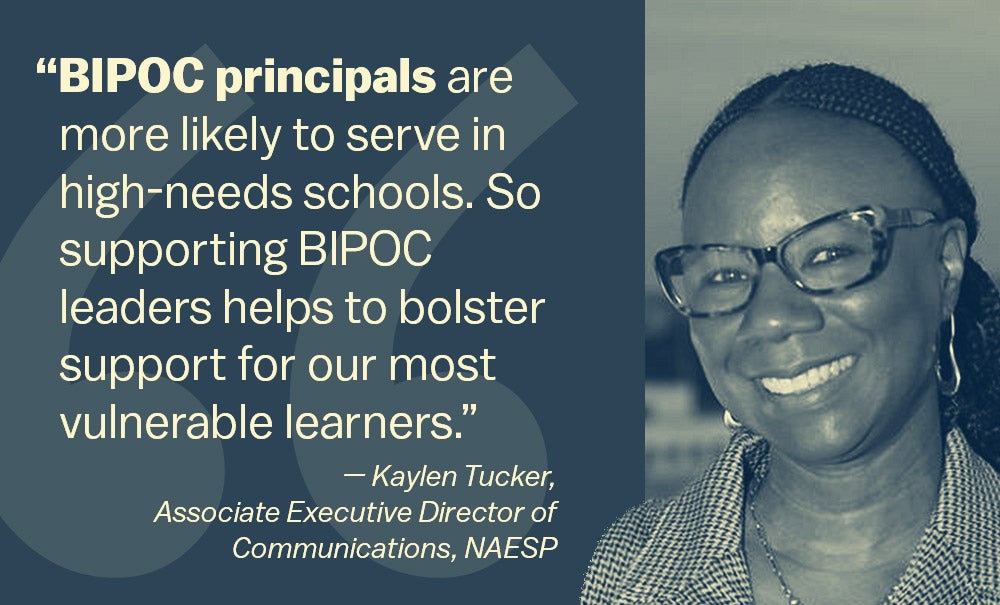Good principal preparation and principal leadership are not only key elements in the success of students, but are also imperative for the social, emotional, and academic lives of Black students in public schools, says Linda C. Tillman, a distinguished visiting professor in the School of Education’s Educational Leadership for Social Justice doctoral program at Loyola Marymount University.
Tillman will be giving the Wallace Foundation Distinguished Lecture at the 2023 American Educational Research Association (AERA) Annual Meeting, the single largest gathering of scholars in the education research field. Her speech will draw on research and center on the importance of effective principal preparation programs and principal leadership for Black students in public schools.
Tillman’s research has focused on school leadership, the education of Black students in K-12 education, culturally sensitive research approaches, and mentoring in higher education.
In fact, she was the mentor of Wallace’s education leadership program officer, Angel Miles Nash. “The funny full-circle story is that Dr. Tillman’s retirement celebration in 2014 was my entrance into AERA and the first event I attended,” Miles Nash recalls. “Fast forward to today, she has since returned to the academy in many ways and currently, as a visiting scholar at LMU. But she has never left the academy as it relates to mentoring students. She is always mentoring students, junior faculty, senior faculty, everyone. Her reputation precedes her as a champion for all of those groups, not only in education leadership but across the academy in all disciplines in education.”
Miles Nash sat down with Tillman to preview some of the themes in her speech. This interview has been edited for length and clarity.

Angel Miles Nash: You’ve spent several decades as a scholar and leader in the K-12 and higher education sectors focusing on diversity, equity, and inclusion issues in education leadership, making institutional systems more racially equitable, creating supportive structures for students and faculty of color and mentoring students and faculty of color. Can you talk about how you got started with this work and why it is so important?
Linda C. Tillman: I was a quasi administrator in Columbus Public Schools in Ohio before I got my doctorate. Within the school system, I don't really think I noticed much of the inequities in terms of supports that Black students get. I don't really think that I knew much about racial inequity or Black students not being supported when I was teaching, because when I was teaching, I always taught with a lot of Black teachers. When I was a quasi-administrator, there were always a lot of Black administrators in our district. It was when I went to graduate school at Ohio State to get my PhD, that I began to see more broadly. You start to read. You start to go to conferences. You start to explore the literature more, and then you begin to see that these inequities are really on a broader scale than what you had imagined.
I started my faculty career in New Orleans. I remember pretty distinctly saying, "My goodness, this district really needs to make some drastic changes to educate Black students," because I was so unaccustomed to such high failure rates, to unsafe buildings, to not having books, to students not finishing high school. I was so unaccustomed to that kind of an educational culture that when I went there, I was just stunned. I saw so many inequities in terms of Black schools.
That made me think, how does this work for Black people who send their children to school? How do they know that these children are going to get an education? Who's going to be teaching them, and who's going to be leading them? I began to focus on those questions. When I left New Orleans, I went to Detroit. The hyper-segregated context of Detroit was very much like New Orleans—the failure rates of students, the dropout rates of Black students, the constant turnover of superintendents, the underachievement of students. How do the principals lead in these situations where it almost seems like the failure of Black students is a given?
AMN: Can you talk about the representation gap between students and principals? How has the composition of the principal workforce measured up to the rapid changes in student demographics?
LCT: It hasn't. In my speech, I'll point out that 15 percent of all students in public schools are Black students. Only 11 percent of principals in public schools are Black. Several reports that I'll refer to suggest that there are going to have to be more principals of color, period, to keep up with the diversification of the student body in public schools. Right now, Black students are at a disadvantage in terms of having a Black principal, and so are Latinx students. In California public schools, 80 percent of all students are students of color. Twenty percent of all principals are principals of color. There is a huge mismatch there. There is quite a bit of data on the mismatch between students of color, Black students, Latinx students, and principals of color. The literature also suggests that having a Black principal means that you will have more Black teachers. Students will do better academically. The dropout rate will decrease. The suspension rate decreases. The college-going rate increases.
We still have a severe shortage of Black principals so it's a pipeline issue for sure. I'll cite three studies, one that was done for the Wallace Foundation by Jason Grissom, Anna Egalite, and Constance Lindsay. What they talk about is it is absolutely necessary to increase the pipeline of Black principals. What does that mean? Many students might never have a Black principal or a Black teacher. Because there's a teacher shortage and, of course, NASSP said in its 2021 survey, 4 in 10 principals are expected to leave the profession. That is certainly going to point to more Black people leaving the profession or not even entering into the principalship.
AMN: Mentoring has been a big focus of much of your writing. Why is mentoring so valuable to educators?
LCT: I did a case study when I was in New Orleans on a Black female teacher who was in the process of being mentored through the state's mentoring program for novice teachers. That teacher had come from an elite high school with high-performing students, all kinds of awards and accolades. Then she goes to a high school that's low performing. She was beyond frazzled. She was at the lowest she could be. She was having pedagogical issues, in other words, how to teach these Black students who she thought were unruly, and the parents were unruly. She was also having emotional and professional issues in that she felt she was a failure. She even said, "I know they sent you to save me."
Then the same race affiliation, same gender affiliation began to kick in for me. I wanted to know, should the mentors be of the same race? Should they be of the same gender? Should they have similar backgrounds?
I think most teachers who go into teaching need mentoring. Mentoring helps a person get their footing and get their confidence to do what is necessary to move from one level to the next level, particularly in teaching. One of the reasons we have such a high turnover rate of teachers is because not all districts have a structured program.
AMN: Principals can have significant positive impacts on specific student populations, including students of color, low-income students, and English-language learners. What are some practices that define effective school leadership, and how can principals carry out those practices to promote equitable education in their schools?
LCT: Well, in the Grissom, et al. study, they certainly pointed out that leadership is direct and indirect. Directly to me means you are talking with students, you are talking with their parents. Patricia Edwards says when we began desegregation, Black parents became members of the audience. You don't make them feel like they're members of the audience. You let them know that their children matter. Then indirectly, you make sure that the teachers know that the children are important. Their social, emotional, and academic achievement is important, and teachers take seriously what needs to be done to teach these students, particularly, a student like an English language learner. If I were a teacher and I didn't speak another language, or if I were a principal, I would have to go get some mentoring. The other thing is these principal preparation programs tend to still be very generic in terms of their teaching. It's as if everyone who will lead is white and everybody that they will teach is white, which is not the case. Even while schools have these social justice focuses, they're not intentional in trying to help or train leaders who can lead in a particular context, such as English language learners or high populations of Black students who live in high-poverty neighborhoods.
One of the things I'll talk about in my speech is what I call my four dimensions of Black principal leadership. One is resistance to ideologies and individuals opposed to the education of Black students. The second one is the academic and social development of Black students as a priority, so all students as a priority. The third one is the importance of the cultural perspectives of the Black principal. And finally, leadership based on interpersonal caring.
AMN: We know from research that effective principals are important, and their preparation, development and support can make a major difference. Yet, principals’ access to high-quality learning opportunities varies across states and by school poverty level. What advice do you have for policymakers to help make principal preparation more equitable?
LCT: I don't know if the policymakers can do that. I think that's a district issue. Does the district feel that it is important for school leaders, assistant principals, and principals? We've got plenty of policy. We've got the information, but what does the district, the superintendent, the board of education–those people who actually consent to these policies–think is important? It's the district prioritizing it, and then the district working out a way that principals can comfortably engage in professional development.
AMN: Given the ongoing work of diversity, equity and inclusion, can you talk about where things were when you started working in K-12 education and how it has evolved since then?
LCT: Well, I'm not sure we have DEI much anymore. I used to be on the faculty at University of North Carolina-Chapel Hill, and two weeks ago they said, "Take out every word that has anything to do with DEI." There are 13 states that are going to follow the lead of Chapel Hill, so I'm not sure we have DEI. It appears that DEI initiatives have been linked to the backlash against Critical Race Theory. Some states have implemented laws that do not allow the teaching of CRT in schools, universities, or diversity trainings. Similar to CRT, DEI is being viewed as unnecessary. That goes back to leadership preparation. We work in colleges of education that espouse a DEI social justice focus, but if we're being told that we have to take everything out, then how do we do that?
AMN: What gives you hope or encouragement as you look to the future?
LCT: I am hopeful that all children, and especially children of color who are underserved and undereducated, will experience the principal leadership that they deserve. I am hopeful that principals will be committed to the education of all children and will implement policies, practices, and procedures that help to ensure that all students receive more than an adequate education. University leadership preparation programs and other organizations can play a critical role in preparing effective school leaders who will be instrumental in educating all children. There is still much work to be done.



